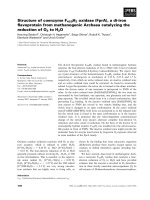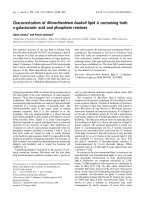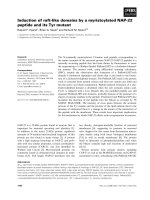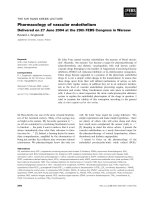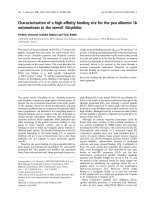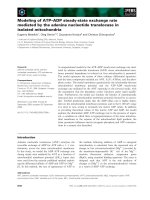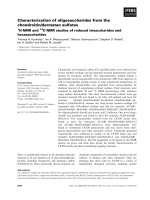Báo cáo khoa học: "Efficacy of different treatment regimes against setariosis (Setaria tundra, Nematoda: Filarioidea) and associated peritonitis in reindeer" doc
Bạn đang xem bản rút gọn của tài liệu. Xem và tải ngay bản đầy đủ của tài liệu tại đây (373.42 KB, 9 trang )
BioMed Central
Page 1 of 9
(page number not for citation purposes)
Acta Veterinaria Scandinavica
Open Access
Research
Efficacy of different treatment regimes against setariosis (Setaria
tundra, Nematoda: Filarioidea) and associated peritonitis in
reindeer
Sauli Laaksonen*
1
, Antti Oksanen
1
, Toomas Orro
2
, Harri Norberg
3
,
Mauri Nieminen
3
and Antti Sukura
4
Address:
1
Finnish Food Safety Authority Evira, Fish and Wildlife Health Research Unit, PO Box 517, FI-90101 Oulu, Finland,
2
Department of
Animal Health and Environment, Estonian University of Life Sciences, Kreutzwaldi 62, 51014 Tartu, Estonia,
3
Finnish Game and Fisheries
Research Institute, Reindeer Research Station, Toivoniementie 246, FI-99910 Kaamanen, Finland and
4
Department of Basic Veterinary Sciences,
Faculty of Veterinary Medicine (FINPAR), University of Helsinki, P.O. Box 66, FI-00014 Helsinki, Finland
Email: Sauli Laaksonen* - ; Antti Oksanen - ; Toomas Orro - ;
Harri Norberg - ; Mauri Nieminen - ; Antti Sukura -
* Corresponding author
Abstract
Background: When a severe peritonitis outbreak in semi-domesticated reindeer was noticed in 2003 in Finland, the
concerned industry urged immediate preventive actions in order to avoid detrimental effects of S. tundra and further
economical losses. A research programme was swiftly initiated to study S. tundra and its impact on the health and
wellbeing of reindeer.
Methods: The ultimate aim of this study was to test the efficacy of different treatment regimes against S. tundra and
associated peritonitis in reindeer. The timing of the trials was planned to be compatible with the annual rhythm of the
reindeer management; (1) the treatment of calves in midsummer, during routine calf ear marking, with ivermectin
injection prophylaxis and deltamethrin pour-on solution as a repellent against insect vectors, (2) the treatment of infected
calves in early autumn with ivermectin injection, and (3) ivermectin treatment of breeding reindeer in winter. The results
were assessed using the post mortem inspection data and S. tundra detection. Finally, to evaluate on the population level
the influence of the annual (late autumn-winter) ivermectin treatment of breeding reindeer on the transmission dynamics
of S. tundra, a questionnaire survey was conducted.
Results: In autumn, ivermectin treatment was efficient against peritonitis and in midsummer had a slight negative impact
on the degree of peritonitis and positive on the fat layer, but deltamethrin had none. Ivermectin was efficient against adult
S. tundra and its smf. All the reindeer herding cooperatives answered the questionnaire and it appeared that antiparasitic
treatment of reindeer population was intense during the study period, when 64–90% of the animals were treated. In the
southern part of the Finnish reindeer husbandry area, oral administration of ivermectin was commonly used.
Conclusion: Autumn, and to a lesser degree summer, treatment of reindeer calves with injectable ivermectin resulted
in decreased severity of peritonitis and perihepatitis in reindeer calves due to setariosis. In the case of necessity for animal
welfare reasons, treatment during early autumn round ups should be considered. On the population level, massive and
routinely applied antiparasitic treatments can improve the health of breeding reindeer and decrease the mortality and
the number of carriers but during the outbreak could not prevent its movement and expansion to the North.
Published: 16 December 2008
Acta Veterinaria Scandinavica 2008, 50:49 doi:10.1186/1751-0147-50-49
Received: 16 September 2008
Accepted: 16 December 2008
This article is available from: />© 2008 Laaksonen et al; licensee BioMed Central Ltd.
This is an Open Access article distributed under the terms of the Creative Commons Attribution License ( />),
which permits unrestricted use, distribution, and reproduction in any medium, provided the original work is properly cited.
Acta Veterinaria Scandinavica 2008, 50:49 />Page 2 of 9
(page number not for citation purposes)
Background
In 2003, an emerging peritonitis outbreak caused by
Setaria tundra appeared in reindeer (Rangifer tarandus
tarandus) in Finland. The proportion of reindeer calf vis-
cerae condemned due to lesions possibly associated with
S. tundra in meat inspection increased from 4.9% in 2001
to 40.1% in 2003 in the southern part of the Finnish rein-
deer herding area and subsequently the focus of the out-
break moved approximately 200 km northwards during
next two years. [1]
The genus Setaria (Filarioidea: Onchocercidae) includes
43 species that are found mostly in the abdominal cavities
of artiodactyls, but also in equids and hyracoids [2]. All
produce microfilariae (mf) which are present and availa-
ble for vectors in host blood. Known vectors are haemat-
ophagous mosquitoes (Culicidae spp) [2] and horn flies
(Haematobia spp.) [3].
Setaria tundra was first described in semi-domesticated
reindeer in Arkhangelsk area [4], and later reported in
reindeer from the Baikal area [5]. Peritonitis caused by S.
tundra was first in 1973 seen in Swedish reindeer [6]. Fur-
ther, in 1973, S. tundra was observed for the first time in
northern Norway, also there associated with an outbreak
of peritonitis [7]. Moreover in 1973, tens of thousands of
reindeer died in the northern part of the Finnish reindeer
husbandry area. Following this, the parasite became
oblivious in reindeer in Finland until the outbreak
emerged again in 2003 [1].
Endectocidic antiparasitic treatment is widely and rou-
tinely used in Finnish reindeer management in every late
autumn and early winter when the breeding reindeer are
treated with ivermectin during autumn round-ups or later
in winter corrals in areas where they are gathered for feed-
ing for winter months. Originally, treatment with various
insecticides was targeted against warbles (Hypoderma
tarandi) and throat bots (Cephenemyia trompe). After the
discovery of ivermectin, the first endectocidic macrocyclic
lactone, the spectrum of the routine antiparasitic treat-
ment broadened to control also potentially harmful gas-
trointestinal nematodes [8]. To our knowledge, there are
no earlier reports on the effect of ivermectin against S. tun-
dra.
Haematophagus insects are supposed to serve as vectors of
S. tundra and the principal transmission time is during the
mass appearance of insects (räkkä-time) coexistent with
or following the microfilaremia peak in reindeer blood
circulation, from middle of June to the end of July [9].
Insecticides have played a central role in controlling the
major insect vectors of infectious diseases such as malaria,
filariosis and haemorrhagic fever since the early 20th cen-
tury. Deltamethrin is a synthetic pyrethroid with a strong
insecticidic effect and a good molecular stability against
adverse environmental conditions such as sunshine and
rainfall, as reviewed by [10]. Pyrethroids are known to
possess high activity against a broad spectrum of insect
pests, both adults and larvae, with low acute toxicity
against mammals and lack of persistence in the environ-
ment [11-13]. Because of these properties deltamethrin is
used widely also in northern Finland, for controlling lice
and flies inside cow barns and for controlling mosquitoes
and biting flies on pastures.
In Finland, reindeer husbandry is practiced by a system of
reindeer herding cooperatives. They are geographically
defined profit-making reindeer husbandry units whose
members, or shareholders, are reindeer owners. When the
peritonitis outbreak in semi-domesticated reindeer was
first noticed in 2003 in the south eastern part of the Finn-
ish reindeer-herding area, the Reindeer Herders' Associa-
tion and individual cooperatives urged immediate
antiparasitic treatment trials in order to prevent detrimen-
tal effects of S. tundra and further economical losses.
A research programme was swiftly initiated to study S. tun-
dra and its impact on the health and wellbeing of rein-
deer. The timing of the field trials was planned to follow
the natural annual rhythm of the reindeer management
and in periods when the mostly free ranging reindeer
could be handled. The reindeer are driven to large herds
in Midsummer by the plague of blood-sucking insects and
in autumn by rutting season. In these periods the reindeer
are rounded up into summer, autumn or winter corrals for
various tasks such as counting, ear marking, transporta-
tion and slaughter.
The ultimate aim of the study was to test the efficacy of
different treatment regimes against S. tundra and associ-
ated peritonitis in reindeer. On the individual level we
aimed to learn if the treatments could prevent or decrease
the infection of reindeer calves, decrease the pathology
leading to carcass condemnation and improve health of
calves. On the population level the aim was to evaluate
the influence of the annual (late autumn-winter) ivermec-
tin treatment of breeding reindeer on the population
dynamics and the transmission of S. tundra from carriers
to calves. To achieve these goals, we conducted three field
trials at three different times of the year: (1) the treatment
of calves in midsummer, during routine calf ear marking,
with ivermectin injection prophylaxis and deltamethrin
pour-on solution as a repellent against insect vectors, (2)
the treatment of infected calves in early autumn with iver-
mectin injection, and (3) ivermectin treatment of breed-
ing reindeer in winter. Finally a questionnaire survey was
conducted including a collection of the status of the
antiparasitic treatment in the Finnish reindeer manage-
ment during the outbreak.
Acta Veterinaria Scandinavica 2008, 50:49 />Page 3 of 9
(page number not for citation purposes)
Materials and methods
The experiments were made in Kuusamo, a then highly S.
tundra endemic area in the south-eastern part of the Finn-
ish reindeer husbandry area (Fig 1). In 2003, the preva-
lence of S. tundra infection in the area was 89% in calves
and 36% in adults, and the corresponding peritonitis
prevalence in calves was 57% [1]. All the post mortem
inspections were performed in Kuusamo reindeer slaugh-
terhouse during routine slaughter. The post mortem
inspections and meat inspection decisions were made by
an experienced reindeer meat inspection veterinarian (S.
Laaksonen).
Autumn ivermectin trial (Trial I)
On November 11
th
, 2003, twenty two random reindeer
calves were captured during autumn slaughter round-up.
Eleven calves (7 males, 4 females) were treated with iver-
mectin injection (estimated body weight 50 kg; 200 μg/kg
b.w. s.c. Virbamec
®
10 mg/ml, Virbac), and another eleven
(8 males, 3 females) formed the untreated control group.
Both groups were individually marked with number ear
tags and released back to range free until slaughter. Six
calves from both groups were slaughtered on December
16
th
(35 days post treatment), and the rest on January
12
th
, 2004 (62 days post treatment), for post mortem
inspection, S. tundra detection in abdominal cavity and
mf detection in the blood. The degree of peritonitis and
perihepatitis was estimated according to [1] and S. tundra
microfilaria (smf) detection was made from blood as
described earlier in [9].
Winter ivermectin trial (Trial II)
Another experiment was carried out just after reindeer
slaughter season 2003, after breeding reindeer had been
collected to the winter corrals for routine winter manage-
ment including antiparasitic treatment and (supplemen-
tal) feeding. This is the standard treatment regime in
Finnish reindeer herding, when the majority of breeding
reindeer are adults whereas. Reindeer (n = 200) belonging
to six different reindeer owners were allocated into six dif-
ferent corrals according to ownership. All corrals were sit-
uated within a 30 km range in the Kuusamo district. In
summer the reindeer had been grazing on common sum-
mer pastures and in the winter similar supplemental feed-
ing was utilized. The feed included silage, commercial
reindeer fodder, dry hay and a small amount of lichen.
Initially, reindeer had already been in corrals, from one
week to one month prior to the study beginning. The rein-
deer were randomly divided into two groups, 100 in each,
and handled on January18
th
, 2004. All adult reindeer were
breeding females while the sex of the calves was not
recorded. The first group (22 calves, 78 adults) received
ivermectin injection (Bimectin
®
, Vetpharma AB) s.c. in the
neck (200 μg/kg b.w). The second group (20 calves, 80
adults) acted as an untreated control group. Blood sam-
ples were collected on March 2
nd
and 3
rd
, 2004 from vena
jugularis (Venoject
®
VP-100SDK) employing 12G Ven-
oject
®
needles. Subsequently, smf-detection and identifi-
cation was performed as described by Laaksonen et al.
(2008) [9].
Summer ivermectin and deltamethrin trial (Trial III)
Setaria tundra prophylaxis in reindeer calves was tested by
giving ivermectin injection as an anthelmintic or deltam-
ethrin pour-on solution as an insect vector repellent in
midsummer 2004. The treatment was performed during
the calf ear-marking, which took place at the onset of the
mass appearance of insect vectors. Calves were treated
between June 26
th
and July 4
th
, 2004. The calves were sys-
tematically allocated into groups, 175 animals each,
weighed and ear-tagged during the routine earmarking
event. One group was treated with ivermectin (Virbamec
®
)
The Finnish reindeer husbandry area (black) divided into four areas to estimate the efficiency of the yearly ivermectin treatment against S. tundra on the population levelFigure 1
The Finnish reindeer husbandry area (black) divided into four
areas to estimate the efficiency of the yearly ivermectin
treatment against S. tundra on the population level.
Acta Veterinaria Scandinavica 2008, 50:49 />Page 4 of 9
(page number not for citation purposes)
injection (200 μg/kg b.w. s.c.) by tuberculine syringes and
needles (Terumo, 20G, 1.5 inch), the second group
received deltamethrin 50 mg (5 ml Coopersect spot on
®
10 mg/ml (Schering-Plough Animal Health), on the skin,
on the withers by a 5 mm thick plastic catheter. The third
group was an untreated control group.
Altogether 109, 108 and 115 calves were slaughtered from
the ivermectin group, the deltamethrin group and the
control group, respectively. The slaughter of the calves
extended from November 4
th
, 2004 until February 7
th
,
2005 in seven slaughter batches. The rest of the marked
calves (66, 67 and 60, respectively) were either not
observed in the winter round-ups or were left alive for
breeding purposes. Those calves not observed at all had
most probably succumbed during summer pasturing (pre-
dation by large carnivores is high in the area [14]). Post
mortem examination was performed on the slaughtered
animals and pathological changes were documented.
Blood samples for mf detection were collected and smf
recognized and counted as described in [9]. Slaughter
weights and back (rump) fat layers were measured by slide
calibre, adult S. tundra worms were counted and the
degree of peritonitis and/or perihepatitis was assessed as
described before [1]. The daily weight gain was calculated
by subtracting the live weight at marking from live weight
at slaughter and dividing the result with days between
marking and slaughter. The live weight at slaughter was
estimated by the relationship of carcass weight to the
body weight, which in reindeer calves is around 50% [15].
To exclude the impact of other parasites on the wellbeing
of the calves, faecal samples were collected from the rec-
tum and examined fresh for the eggs of Trichostrogylidae
spp. Nematodirus spp., Capillaria sp. and Moniezia sp. and
oocysts of Eimeria spp. Faecal samples were examined
according to a modified McMaster method, each egg rep-
resenting 20 eggs per gram (epg) at Evira Fish and Wildlife
Health Research Unit laboratory in Oulu. Warble fly lar-
vae were counted during skinning at slaughter.
Questionnaire
The status of the antiparasitic treatment (prevalence of
treatment, proportions of injection and oral treatment) in
all 56 cooperatives of the Finnish reindeer herding area in
2002, 2003 and 2004 was collected by a questionnaire
addressed to the chiefs of the cooperatives. The question-
naire was performed by a form which was delivered by
post and in some cases completed by phone call.
The reindeer-herding area was divided into four areas as
described to estimate the efficiency of the yearly ivermec-
tin treatment against S. tundra in the population level (Fig.
1) (see also [9]).
Statistic
Statistical analyses were performed with Stata 9 (Stata-
Corp LP, USA) software.
In the first and second trial the Pearson' chi square test
was used to analyse ivermectin treatment effect to the
meat inspection findings and to the S. tundra and smf
prevalence.
In trial three, logistic regression was used to analyse the
medication effect (two medications versus no treatment)
to the degree of peritonitis (0–1 versus 2–3 in [1]), pres-
ence of perihepatitis, prevalence of S. tundra nematodes
and smf in blood or to the prevalence of other parasites.
Logistic regression was also used for studying associations
between peritonitis degree and perihepatitis with the
prevalence of nematodes in abdominal cavity or smf in
blood. Pearson goodness-of-fit test was used to validate
all logistic regression models. Differences between treat-
ment groups and controls in slaughter weight, daily
weight gain and thickness of back fat layer were tested
using linear regression models. Days from treatment to
slaughter were included in all linear regression models as
significant predictor. Sex was included in daily weight
gain and slaughter weight models and weight at treatment
in daily weight gain model. Model assumptions were
checked using scatter and normality plots of the models'
standardised residuals. Square root transformation of fat
layer was used to achieve validity of linear regression
model. The level of significance was set at 5% (p < 0.05).
Results
Trial I
In post mortem examination during the slaughter, none
of the ivermectin group calves were found to have live S.
tundra nematodes in abdominal cavity whereas all the
reindeer in the control group had an average of 4.5 (SD
6.25) live worms (p < 0.001). In eight calves (73%) of the
ivermectin group, dead, more or less degenerated nema-
todes or their remains were detected in contrast to the
control group where no dead nematodes were found. All
the reindeer (n = 11) in the control group and three rein-
deer (27%) of the ivermectin group slaughtered in the lat-
ter slaughter batch on January 12
th
, 2004, had smf in the
blood circulation (p < 0.001). There was a significant (p <
0.001) difference in prevalence of peritonitis (peritonitis
degrees 0–1 versus 2–3) between groups. Nine of the
calves in the control group had peritonitis degree 2–3 and
only one in the ivermectin group. In all the six animals
with peritonitis (five degree one, one degree 2) in the iver-
mectin group, the peritonea were described as being dry
and having organized lesions whereas peritonea of all the
animals in the control group were wet with 50 to 150 ml
of ascites fluid in the abdomen.
Acta Veterinaria Scandinavica 2008, 50:49 />Page 5 of 9
(page number not for citation purposes)
Trial II
The calf/adult ratio was not different in the ivermectin and
control groups (p = 0.728). The prevalence of smf in the
ivermectin group was nine times smaller than in the con-
trol group. The results are presented in Table 1.
Trial III
The results obtained at slaughter are presented in Table 2.
There was no significant impact of antiparasitic treatment
in the degree of peritonitis (degrees 0–1 versus higher
than degree 1), prevalence of S. tundra nematodes in the
abdominal cavity or smf in blood. However, significantly
less animals with perihepatitis (p = 0.018) were found in
the ivermectin group compared with the control group.
The degree of peritonitis was positively associated with
finding of S. tundra nematodes in the abdomen (p =
0.002) and smf in the blood (p = 0.047). The prevalence
of parasites, both adult S. tundra (p < 0.001) and smf in
the blood circulation (p = 0.003) and also the degree of
peritonitis (p < 0.001) were positively associated with the
prevalence of perihepatitis.
There were no treatment effects on the daily weight gain
or on the slaughter weight of calves. Treatment effect on
the thickness of the fat layer was also not significant. How-
ever, difference between ivermectin and control group
was close to significance (thicker in ivermectin group; p =
0.052).
There were no significant differences between the preva-
lences of S. tundra or prevalences and densities of other
parasites between treatment groups.
In meat inspection, all the livers classified to perihepatitis
degree 1–3 (see [1]) and peritonea classified to peritonitis
degree 2–3 were condemned. No other pathological
changes or disease leading to condemnation was found in
any group.
Questionnaire
The results of the questionnaire addressed to the chiefs of
the reindeer herders cooperatives (n = 56, response rate
100%) about the history of antiparasitic treatment of rein-
deer with ivermectin in the years 2002, 2003 and 2004 are
presented in Table 3 and Fig 1.
Discussion
The major conclusion of this study is that autumn, and to
a lesser degree summer, treatment with injectable iver-
mectin resulted in decreased severity of peritonitis and
perihepatitis in reindeer calves due to setariosis. The path-
ological changes caused by S. tundra have been associated
to the decrease of the body condition of slaughter calves
[1]. In trial III, a slight benefit of midsummer ivermectin
treatment was detected in the highly endemic area of S.
tundra. Fat layer was thicker in the ivermectin group and
the quality of livers was better, the liver and, especially the
liver capsule, being the primary location of changes
caused by S. tundra.
Antiparasitic treatment of slaughter calves and its benefits
during summer round-ups has been frequently discussed
among reindeer herders during the S. tundra outbreak and
has been practised in some individual cooperatives. In
one earlier study in Finland, [16] no benefit of this type of
treatment to the summer and autumn growth of reindeer
calves could be demonstrated. However, in that work the
study conditions differed from the present in that there
were no observations of S. tundra infection or any associ-
ated pathological changes [1] in the study area.
According to the trial I, autumn antiparasitic treatment of
reindeer calves during heavy outbreak, before slaughter
season, could improve results, maybe not in weight gain
indicators, but by reducing condemnations during meat
inspection. However the economical feasibility of treat-
ment at this time can be questioned. Chemical treatment
of calves to be selected for slaughter could damage the
organic reputation of reindeer meat in foodstuff market
[8]. In Finland, only veterinarians are allowed to give iver-
mectin injections to reindeer which increases the costs of
the antiparasitic treatment and adding the costs from extra
round-ups, total costs could easily exceed the benefit.
Nevertheless, in situations where a heavy outbreak is evi-
dent and the reindeer calves' welfare demands, efficient
antiparasitic treatment is available and should be used.
Ivermectin injection (200 μg/kg b.w. s.c) proved to be effi-
cient against adult S. tundra nematodes in the abdominal
cavities of calves (trial I). It was also efficient against smf
in blood circulation, at least on the individual reindeer
level. In trial I, there were no live S. tundra nematodes in
the abdominal cavity in the treated group. In addition,
healing processes and the organization of the inflamma-
tory changes in the abdominal cavity had clearly started
one month following the ivermectin treatment. This dem-
onstrates that the peritonitis is associated with living S.
Table 1: Number of reindeer and the prevalence of S. tundra
microfilariae in the ivermectin and control groups 44 days after
ivermectin injections (200 μg/kg b.w. s.c.) in winter ivermectin
trial.
Group Ivermectin Control p-value (chi)
Calves (n)
Smf prev.
22
14%
20
95%
p < 0.001
Adults (n)
Smf prev.
78
1%
80
34%
p < 0.001
Total (n)
Smf prev.
100
4%
100
36%
p < 0.001
Acta Veterinaria Scandinavica 2008, 50:49 />Page 6 of 9
(page number not for citation purposes)
tundra nematodes in abdominal cavity as earlier presented
[1]. The results also show that routine antiparasitic treat-
ment, especially of calves which are left alive for breeding
purposes, is well funded.
In trial I, none of the six calves slaughtered 30 days after
ivermectin treatment had live smf in the blood circula-
tion, but three of the five calves slaughtered 57 days after
treatment had. In trial II, the proportion of smf positives
was 4% of the treated reindeer 44 days after ivermectin
injections. The results may indicate partial efficiency of
ivermectin against migrating larvae [17], which might
have subsequently matured and started to produce smf.
However, this part of S. tundra nematode's life cycle is still
poorly understood. The possible bias because of reinfec-
tion was not possible because of the luck of insects and S.
tundra nematodes' 3 to 4 month's pre-patent time [9]. The
variable efficiency of ivermectin against the developing
stages of filarioidea nematodes has been shown earlier by
[17]. Another possibility is that the larval output was tem-
porarily suppressed by ivermectin as shown in other filar-
ioidea species reviewed by [18]. Ivermectin is also
commonly used in the control of human filariosis because
of its potent effect on mf [19]. Although there is currently
no formal evidence for the development of resistance to
any drug used against filariasis several cases of 'non- or
poor responsiveness' to treatment of onchocerciasis with
ivermectin have been reported [20]. This is also important
Table 2: Number of reindeer calves, and weight, health and parasitological parameters assessed during slaughter after ivermectin or
deltamethrin treatment during ear marking in midsummer.
Group
n (male/female)
Ivermectin
109 (63/46)
Deltamethrin
108 (60/48)
Control
115 (64/51)
Weight during treatment
mean, SD
19,3 kg, 4.6 20.8 kg, 3.8 21 kg, 3.7
Carcass weight at slaughter
mean, SD
23,4 kg, 3.2 23.8 kg, 2.7 23.7 kg, 3.0
Weight gain
mean, SD
27.6 kg, 5.7 26.6 kg, 4.8 26.5 kg, 5.4
Daily weight gain
mean, SD
194 g, 0.6 185 g, 0.5 185 g, 0.5
Fat layer
mean, SD
4.7 mm, 4.9 4.1 mm, 3.2 3.7 mm, 4.2
Peritonitis (degree 2–3) 8% 20% 16%
Perihepatitis (degree 1–3) 48%
1
66% 64%
S. tundra in abdomen 69% 69% 71%
Smf in blood 23% 22% 25%
Nematodirus spp. prev.%
mean epg in infected, (SD)
18%
43, (34)
20%
39, (25)
16%
46, (32)
Trichostrogylidae spp. prev %
mean epg in infected, (SD)
49%,
79, (101)
61%
74, (69)
61%
83, (108)
Moniezia sp. prev.%
mean epg in infected, (SD)
16%
872, (1144)
16%
552, (883)
18%
989, (1295)
Capillaria sp. prev.%
mean epg in infected, (SD)
10%
38, (31)
9%
47, (35)
8%
28, (10)
Eimeria spp. prev.%
mean epg in infected, (SD)
54%
17502, (12237)
45%
553, (1192)
48%
732, (1202)
Hypoderma tarandi prev.% (mean in infected) 9%
3.3
6%
2.3
9%
2
1
Significantly different (p = 0.018) from control group
Table 3: Frequency of antiparasitic – treatment of breeding reindeer in autumn/early winter 2002–2004 with ivermectin inj. 200 μg/kg
s.c. or paste 200 μg/kg per os and reindeer densities (see fig 1).
year 2002 2003 2004 Reindeer/km
2
in summer 2003
area inject/paste inject/paste inject/paste
1 52%/24% 57%/23% 68%/17% 1.6
2 82%/4% 83%/4% 75%/2% 2.2
3 77%/0.2% 87%/0.3% 90%/0.2% 2.8
4 59%/5% 64%/5% 66%/5% 3.4
tot 69%/7% 73%/7% 75%/5% 2.5
Acta Veterinaria Scandinavica 2008, 50:49 />Page 7 of 9
(page number not for citation purposes)
to keep in mind, especially after decades of mass ivermec-
tin treatment of Finnish reindeer population [8]. Overall,
the results obtained from our trials were comparable to
earlier reports in which the variable efficiency of ivermec-
tin against Setaria spp. infection has been demonstrated in
domestic animals. These results demonstrate that the effi-
ciency of ivermectin (200 μg/kg b.w.) against the circulat-
ing Setaria microfilariae (smf) is better, varying from 88 to
100%, than against the adult worms (67–84%) [21-26].
Prevention of S. tundra transmission by the insecticide
and mosquito repellent, deltamethrin, was not successful.
It is possible that the effect of pour-on deltamethrin solu-
tion against mosquitoes does not last very long in nature
in the occasionally rainy conditions in Finland. In addi-
tion, the relatively slight preventive effects of both iver-
mectin and deltamethrin treatment during mid summer
round-ups may be due to the transmission dynamics of S.
tundra. The development of smf after the mosquito's
blood meal to the infective stage is temperature depend-
ent and lasts at least about two weeks [2,27-30]. This is
congruent to the conclusion [9] that the most active trans-
mission time of S. tundra is between early July and late
August. In midsummer, the mass appearance of mosqui-
toes has just started and by the time when these interme-
diate hosts become active vectors the plasma
concentration of ivermectin has decreased in reindeer [31]
and deltamethrin is diluted. A more efficient way to pre-
vent transmission in mid summer could be the medica-
tion of the older animals in the herd, the reservoir of S.
tundra especially when the role of wild cervids as reser-
voirs for S. tundra is in North Finland insignificant [9]. A
limitation to this would be the fact that handling is diffi-
cult at that period because of the fragile growing velvet
antlers of adult reindeer.
It has been proposed [16] that reindeer calves pick up gas-
tro-intestinal parasite larvae at an early age in late June or
early July. However the infection pressure of the parasites
is likely strong also later in the summer, which may
explain why there were no distinguishable differences in
the prevalence or intensity of other ecto- and endoparasite
infections between groups in this study. Another explana-
tion, parasite resistance to ivermectin because of wide-
spread and long standing use of ivermectin, demands
further research efforts.
According to the questionnaire antiparasitic treatment
with ivermectin was relatively intensive in 2002–2004:
about 80% of Finnish reindeer got medication. The use of
equine ivermectin paste administered per os was common
in southern areas. In the area 1 in 2002, just before the
outbreak, 24% of reindeer got paste and only 52% got
ivermectin administered by injection. During the course
of the outbreak, the proportion of injection increased to
68%. This was mainly due to advice given by the Reindeer
Herders' Association and by the reindeer health care pro-
gramme by Finnish Food Safety Authority Evira. The use
of oral administration of ivermectin was not recom-
mended because of the weaker efficiency against gastroin-
testinal nematodes [32,33], lower achieved plasma
concentrations and the danger of emerging drug resist-
ance [31]. It is unclear if the high proportion of reindeer
treated by oral administration of ivermectin is connected
with the genesis of the outbreak in this area [1] where the
reindeer density is only about half of the densities in the
two northern areas (Table 3). Although mf are usually
very susceptible to ivermectin, the adult filarioids are not
[17]. It is reasonable to think that the lower ivermectin
concentration in reindeer achieved by oral administration
has lesser efficiency against adult S. tundra nematodes. In
the area 3, the treatment with ivermectin injection was
intensive during the study period, 87% of reindeer in
2003 and 90% in 2004, which is almost as high as it could
ever realistically get in reindeer management. Even then,
the outbreak emerged to the area; 63% of viscera con-
demned in 2005 and the prevalence of smf positive rein-
deer calves increased from 16% in 2004 to 60% in 2006.
Simultaneously, the outbreak settled down in the south-
ern area [1,9].
The results obtained from this study give additional evi-
dence of the pathogenity of S. tundra to reindeer and sug-
gest that a heavy infection rate may have detrimental
effects on Rangifer populations. In addition, recent studies
give rise to the hypothesis that the currently high preva-
lence of filarioid nematodes in cervids [1,9] and in cattle
[34] in Finland may be associated with the ongoing cli-
mate change.
Observations made in this study support the conclusions
of the very efficient transmission and potent vectors of S.
tundra nematodes as well as deductions about the impact
of growing immunity against S. tundra [9] in regulating
the infection degree and dynamics in reindeer popula-
tions. This was also seen earlier in an experiment when
hinds in the zoo with very low smf value managed to
transfer the infection to their offspring and all infected
calves cleared the infection within two years [9]. It is likely
that on the population level, these factors are more impor-
tant than the field efficiency of ivermectin in regulating S.
tundra infection transmission to the next generation.
Therefore, it is essential to gain knowledge of the basic
biology and dynamics as well as preventive measures,
including drug resistance studies, against these nema-
todes, there is growing interest in the subarctic areas.
Conclusion
The major conclusion of this study is that autumn, and to
a lesser degree summer, treatment of reindeer calves with
Acta Veterinaria Scandinavica 2008, 50:49 />Page 8 of 9
(page number not for citation purposes)
injectable ivermectin resulted in decreased severity of peri-
tonitis and perihepatitis in reindeer calves due to setario-
sis. During a heavy outbreak, early autumn treatment can
improve the health and the quality of slaughter calves, but
it would detract the eminence of reindeer meat. On the
other hand, mid-summer treatment of calves during ear-
marking round-ups with ivermectin or deltamethrin is
neither efficient nor cost-effective. Ivermectin has good
efficiency against adult S. tundra nematodes in abdominal
cavity and circulating smf and then there is obligation and
good possibility to treat heavily infected reindeer calves
with ivermectin injection (200 μg/kg b.w. s.c.) for
humane reasons. On the population level, massive and
routinely applied antiparasitic treatments can decrease the
number of carrier reindeer in next summer. The fact that
this could not prevent the movement of the S. tundra out-
break to new areas in the North, indicates efficient trans-
mission dynamics of S. tundra. On the other hand, the
present intensity of antiparasitic treatment may possibly
have prevented the mass mortality of breeding reindeer in
winter as described earlier in 1973 [1] by improving the
health of breeding reindeer.
Competing interests
The authors declare that they have no competing interests.
Authors' contributions
SL carried out the design and the realization of the study
and trials. SL also drafted the manuscript. AO and AS par-
ticipated in the design and coordination of the study and
were also active in writing process. TO helped and partic-
ipated in statistical analyzes. HN and MN partly coordi-
nated and designed the study and helped in drafting the
manuscript. All authors involved in the analysis of the
data, gave their valuable views, read and approved the
final manuscript.
Acknowledgements
The authors thank the Kallioluoma Reindeer Herding Cooperative for
assistance and patience, Orion Pharma Oy and Vetcare Oy for part-funding
this study and Ministry of Agriculture and Forestry (MAKERA) for funding
the Reindeer Health Care Program, which constituted the basis of this
study. We also thank the laboratory personnel of Evira in Oulu, for assist-
ance and Hannu Ylönen and Raine Kortet who gave us valuable comments
on the manuscript and anonymous reviewers for very constructive criti-
cism.
References
1. Laaksonen S, Kuusela J, Nikander S, Nylund M, Oksanen A: Parasitic
peritonitis outbreak in reindeer (Rangifer tarandus tarandus)
in Finland. Vet Rec 2007, 160:835-841.
2. Anderson RC: The Superfamily Filaroidea. In Nematode Parasites
of Vertebrates; Their Development and Transmission 2nd edition. New
York: CABI Publishing; 2000:467-529.
3. Shol' VA, Drobischenko NI: Development of Setaria cervi
(Rudolphi, 1819) in Cervus elaphus maral. Helminthologia, Bra-
tislava 1973, 14:214-246.
4. Rajevsky SA: Zwei bisher unbekannten Nematoden (Setarien)
von Rangifer tarandus und von Cervus canadensis asiaticus. Z
Infekt Krankh Hyg 1928, 35:40-52.
5. Shagraev MA, Zhaltsanova DSD: A study of the helminth fauna of
domestic deer in the Buryat ASSR. Fauna I resursy pozvonoch-
nykh basseina ozera Baikal 1980:128-130.
6. Rehbinder C, Christensson D, Glatthard V: Parasitic granulomas
in reindeer. A histopathological, parasitological and bacteri-
ological study. Nord Vet Med 1975, 27:499-507.
7. Kummeneje K: Diseases in reindeer in northern Norway. Pro-
ceedings of the Symposium of the Second International Reindeer – Caribou
Symposium: 17–21 September 1979; Röros, Norway 1980, Part
B:456-458.
8. Oksanen A: Endectocide treatment of the reindeer. Rangifer
1999.
9. Laaksonen S, Solismaa M, Orro T, Kuusela J, Saari S, Kortet R,
Nikander S, Oksanen A, Sukura A: Setaria tundra microfilaria in
reindeer and other cervids in Finland. Parasitol Res 2008 in
press. (810.1007/s00436-008-1184-0)
10. Villarini M, Moretti M, Pasquini R, Scassellati-Sfozolini G, Fatigoni G,
Marcarelli M, Monarca S, Rodr'iquez AV: In vitro genotoxic effects
of the insecticide deltamethrin in human peripheral blood
leucosytes: DNA damage ('comet' assay) in relation to the
induction of sister-chromatid exchanges and micronuclei.
Toxicology 1998, 130:129-1399.
11. Papadopoulou-Markidou E: Analysis of established pyrethroid
insecticide.
Residue Review 1983, 89:179-208.
12. Zerba E: Insecticidal activity of pyrethroids on insects of med-
ical importance. Parasitol Today 1988, 4:53-57.
13. Vijveberg HPM, Bercken J Van den: Neurotoxicological effect and
the mode of action of pyrethroid insecticides. Crit Rev Toxicol
1990, 21:105-126.
14. Norberg H, Nieminen M: The impact of wolf predation on sur-
vival pattern and rate of orphan calves in semi-domesticated
reindeer in southeastern Finnish reindeer management
area. Book of Abstracts of the International Union of Game Biologists
XXVIII Congress 2007:239.
15. Nieminen M, Petersson CJ: Growth and relationship of live
weight to body measurements in semi-domesticated rein-
deer (Rangifer tarandus tarandus). Rangifer 1990:353-361.
16. Oksanen A, Norberg H, Nieminen M: Ivermectin treatment did
not increase slaughter weight of first-year reindeer calves.
Prev Vet Med 1998, 35:209-217.
17. Campbell WC: Efficacy of the avermectins against filarial par-
asites: a short review. Vet Res Com 1982, 5:251-262.
18. Osei-Atweneboana M, Eng J, Boakye D, Gyapong J, Prichard R: Prev-
alence and intensity of Onchocerca volvulus infection and
efficacy of ivermectin in endemic communities in Ghana: a
two-phase epidemiological study. The Lancet 2007,
369:2021-2029.
19. Ottesen EA, Cambell WC: Ivermectin in human medicine. J Anti-
microb Chemother 1994, 34:195-203.
20. Molyneux DH, Bradley M, Hoerauf A, Kyelem D, Taylor MJ: Mass
drug treatment for lymphatic filariasis and onchocerciasis.
Trends in Paras 2003, 19:516-522.
21. Verma KAK, Kumar M, Sharma SP: Therapeutic studies on exper-
imental Setaria cervi infection in rabbits. Int J Anim Sci 1994,
9:231-232.
22. Shirasaka S, Suzuki M, Endou G, Adachi Y, Taira N: Efficacy of iver-
mectin against Setaria microfilariae in calves and cerebrospi-
nal setariosis in sheep and goats. J Vet Med Sci 1994,
56(6):1213-1214.
23. Sharma SP: Treatment of clinical microfilariasis in buffaloes
with ivermectin. Indian Vet J 1991, 68:972-974.
24. Singh OV, Singh JL, Dabas YPS: Efficiacy of ivermectin in concur-
rent infestation of Setaria and mange in buffalo bulls. Indian J
Vet Med 1999, 19:68-69.
25. Klei TR, Torbert BJ, Ochoa R: Efficiacy of ivermectin (22,23 dihy-
droavermectin B1) Against Adult Setaria equine and Micro-
filarie of Onchocerca cervicalis and Microfilarie of
Onchocerca cervicalis in Ponies. J Parasitol 1980, 66:859-851.
26. Sharma SP, Siddiqui AA: Efficcacy of three anthelmintics in
experimentally induced setariosis in lambs. J Vet Parasitol 1996,
10:159-163.
Publish with BioMed Central and every
scientist can read your work free of charge
"BioMed Central will be the most significant development for
disseminating the results of biomedical research in our lifetime."
Sir Paul Nurse, Cancer Research UK
Your research papers will be:
available free of charge to the entire biomedical community
peer reviewed and published immediately upon acceptance
cited in PubMed and archived on PubMed Central
yours — you keep the copyright
Submit your manuscript here:
/>BioMedcentral
Acta Veterinaria Scandinavica 2008, 50:49 />Page 9 of 9
(page number not for citation purposes)
27. Nelson GS: Observations on the development of Setaria labi-
atopapillosa using new techniques for infecting Aedes
aegypti with this nematode. J Helminth 1962, 36:281-296.
28. Zhong-Xing L, Li-rong Y: Morphological studies on the larval
stages of three species of Setaria and Dirofilaria repens.
Southeast Asian J Trop Med Public Health 1990, 21(1):95-102.
29. Pietrobelli M, Cancrini G, Frangipane di Regalbono A, Galuppi R,
Tampier MP: Development of Setaria labiatopapillosa in Aedes
caspius. Med Vet Entomol 1998, 12:106-108.
30. Wajihullah : Comparative account of developing larvae of
Setaria cervi and Diplotriaena tricuspis. J Vet parasitol 2001,
15:117-120.
31. Oksanen A, Norberg H, Nieminen M, Bernstad S: Influence of
route of administration on the plasma concentrations of
ivermectin in reindeer. Res Vet Sci 1995, 58:286-287.
32. Oksanen A, Nieminen M, Soveri T, Kumpula K: Oral and
parenteral administration of ivermectin to reindeer. Vet Par-
asitol 1992, 41:241-247.
33. Oksanen A, Nieminen M, Soveri T: A comparison of topical, sub-
cutaneous and oral administration of ivermectin to reindeer.
Vet Rec 1993, 133:312-314.
34. Solismaa M, Laaksonen S, Nylund M, Pitkänen E, Airakorpi R, Oksanen
A: Filarioid Nematodes in Cattle, Sheep and Horses in Fin-
land. Acta Vet Scan 2008, 50:20.



